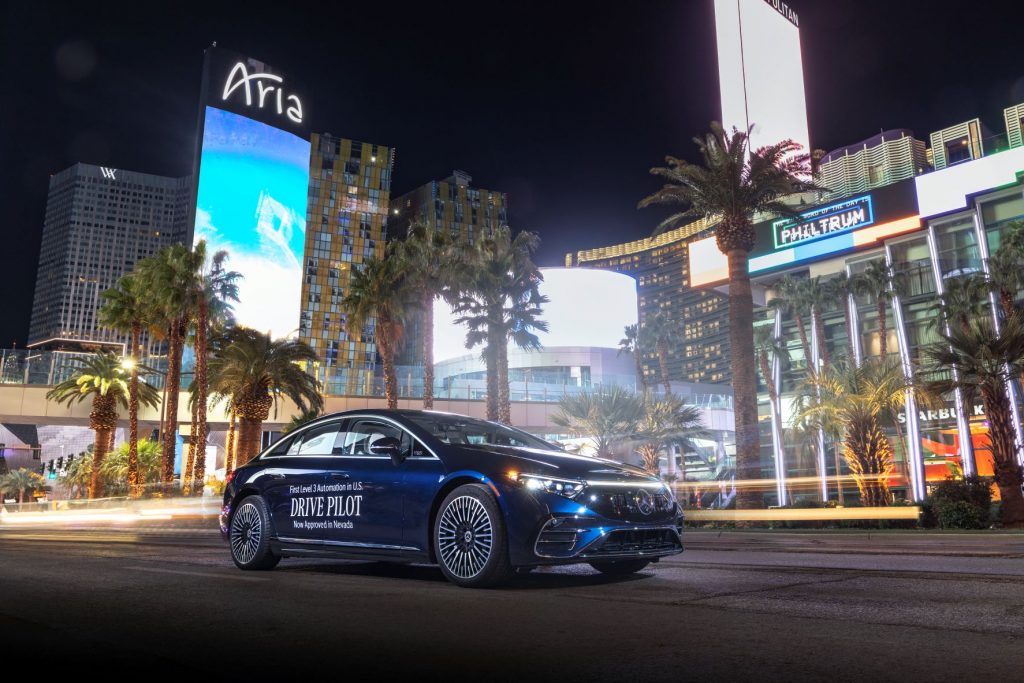
Mercedes-Benz is the world’s first automotive company to bring SAE Level 3 conditionally automated driving to the U.S., with Nevada being the first state to confirm the compliance of the system with state regulations. The Level 3 label means that the automated driving function takes over certain driving tasks, but a human driver is still required and must be ready to take control when prompted to intervene by the vehicle.
The Mercedes-Benz Drive Pilot was the first Level 3 system in the world to meet the demanding requirements of UNR157 when it was introduced in Germany in May 2022. The German KBA (Federal Motor Transport Authority) first granted system approval based on the regulation, paving the way for offering the system internationally where legislation allows.
The new milestone makes the automaker’s Drive Pilot system the first Level 3 system in a standard-production vehicle authorized for use on U.S. public freeways. Complying with the requirements of Nevada Chapter 482A for Autonomous Vehicles, the system will allow the driver to hand over the dynamic driving task to the vehicle under certain conditions. Mercedes-Benz intends to expand the capability to California later this year, with the certification documents already filed with state authorities.
Drive Pilot will be available in the U.S. as an option for model year 2024 Mercedes-Benz S-Class and EQS models, with the first cars delivered to customers in the second half of 2023.
“In the modern world, time is one of the most precious commodities, and giving back time to our customers is a core element in our strategy to build the world’s most desirable cars,” said Markus Schäfer, Member of the Board of Management of Mercedes-Benz Group AG, Chief Technology Officer, responsible for Development and Procurement. “Our Drive Pilot takes a major step forward in achieving that and places us at the very forefront of innovation in the crucially important field of automated driving. Certification in Nevada marks the start of its international rollout and, with it, the dawning of a new era.”
On suitable freeway sections and where there is high traffic density, Drive Pilot can take over the dynamic driving task up to 40 mph. Once conditions are suitable, the system indicates its availability on steering-wheel control buttons on the left and right above the thumb recesses. When the driver activates Drive Pilot, the system controls the speed and distance, and keeps the vehicle within its lane. The route profile, events occurring on the route, and traffic signs are taken into consideration. The system also reacts to unexpected traffic situations and handles them independently, by evasive maneuvers within the lane or by braking maneuvers.
If the driver fails to take back control after increasingly urgent prompting and the expiration of the takeover time, the system brakes the vehicle to a standstill while engaging the hazard warning lights. Failure of the driver to respond due to a severe health problem activates an emergency call system and unlocks doors to make the interior accessible for first responders.
“It is a very proud moment for everyone to continue this leadership and celebrate this monumental achievement as the first automotive company to be certified for Level 3 conditionally automated driving in the U.S. market,” said Dimitris Psillakis, President and CEO of Mercedes-Benz USA.

The updated, optional Drive Pilot system builds on the sensors of the Driving Assistance Package with additional sensors the automaker considers indispensable for safe conditionally automated driving. These include a lidar, a camera in the rear window, microphones for detecting emergency vehicles, and a road wetness sensor in the wheel well.
A powerful chipset in the central control unit provides the software functions for conditionally automated driving and algorithms are calculated redundantly within the framework of the security architecture. A Drive Pilot vehicle also has redundant steering and braking actuators and a redundant onboard electrical system so that if one of these systems fails the vehicle remains controllable and a safe handover to the driver can be ensured.
The location of a Mercedes-Benz with Drive Pilot is determined using a high-precision positioning system much more powerful than conventional GPS systems. In addition to the anonymized data collected by sensors, a digital HD map provides data on the road geometry, route characteristics, traffic signs, and special traffic events such as accidents and construction.
This high-precision map has centimeter-level accuracy and complex junction and route models connected to a backend data center. Each vehicle stores an image of the map data on board, constantly compares it with the backend data, and updates the local dataset as required.
For much more detail on the Level 3 Drive Pilot system, check out our earlier coverage here: Mercedes-Benz offers first certified Level 3 automated driving option for production.

